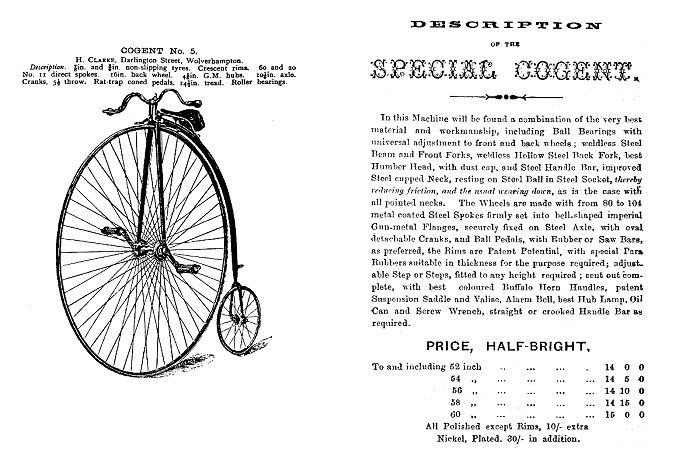|
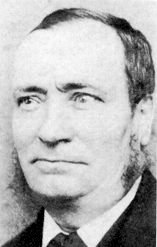
Henry Clarke |
Henry Clarke, a skilled wheelwright and
blacksmith joined the 38th Foot Regiment in
1855, at the outbreak of the Crimean War. He was
wounded in the attack on Redan, and subsequently
discharged. On making his way home via Paris, he
saw his first bicycles. These would have been
hobby horses with wooden wheels, which were very
similar to the carriage wheels that Henry was
familiar with. He realised that he could easily
make this type of wheel himself and so he made
contact with some of the French manufacturers
who were interested in his skills. When he
returned to Wolverhampton he set up the 'Temple
Street Wheel Company' to make all kinds of
wooden wheels for export to France, including
some for velocipedes. At around the same time
he married Harriet Powney from Wombourne and
they had six daughters and five sons. |
|
In the 1861 census the
family is listed as living at Baptist End Lane,
Dudley. Henry Stephen Clarke, aged 28 was born
in Pattingham, and was a Chelsea Pensioner and a
Wheelwright. His wife Harriet, age 25 was born
in Wombourne. Their children were Thomas Clarke,
aged 4, born in Wombourne, George Edward Clarke,
aged 4, born Wombourne, and Sarah A. Clarke,
aged 3, born in Netherton.
Their other children were
Henry, born in 1863, Elizabeth, born in 1865,
William, born in 1867, Jane, born in 1869,
Fanny, born in 1871, John, born in 1875,
Harriet, born in 1878, and Emma, born in 1880.
By 1863 the family had moved to No. 2, Court,
Darlington-street, Wolverhampton.
In 1887 George Edward
Clarke's son died under tragic circumstances, as
can be read in the following newspaper report:
Death of his son. 'An
inquest was held Yesterday, at the Newmarket
Inn, Cleveland Road, Wolverhampton, touching the
death of Henry Stephen Clarke, 4½,
son of George Edward Clarke, blacksmith, Great
Hampton Street. The child was, on Thursday
morning, in the kitchen with a sister eight
years old, when he reached some matches from a
chimney, and some of them being struck, his
nightshirt caught fire. The mother extinguished
the flames with a woollen shawl, but not before
the child had sustained severe burns, from the
effects of which he died in the hospital two
days afterwards. - A verdict of "Accidental
death" was returned. |
| Being a skilled blacksmith he soon picked up
the necessary skills to build complete bicycles
and decided to manufacture them himself. In
1868 he founded the 'Cogent Cycle Company' in
Darlington Street, and was joined by his five
sons; Tom, George, William, Jack, and Henry. The
first Cogent machines appeared in 1869 and sold
extremely well.
By 1877 'Cogent Penny Farthings' were selling
at prices from £8 to £10 and the company was
very successfully producing many different
models. Hubs were made in two halves and when
built-up secured the spokes, and rounded case
hardened cone bearings helped to reduce
friction. |
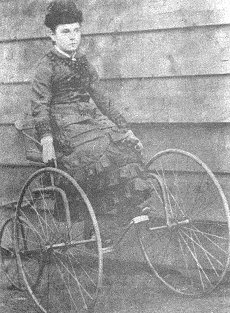
| Bessie
Clarke riding an early Cogent
tricycle in about 1870. Courtesy of
the late Jim Boulton. |
|
| A short
description from "Bicycles of the Year 1877"
by Harry Hewitt Griffin: "The
Cogent.- Henry Clarke, Cogent Bicycle Works,
Darlington Street, Wolverhampton. In days of
bone shakers Henry Clarke was well known as
a maker, and he cannot fail to have gained
great experience as to how a bicycle ought
to be built.
An improved form of rounded
cone bearing is adopted, which appears to be
superior to the ordinary; the working parts
being of case hardened steel, friction is
therefore greatly reduced; the hub is double
(something like Deacon's), and put on in
halves, in which the spokes are firmly
secured. Small good rubber pedals on flat
cranks are used, and the Stanley head is
employed. The handles are low and in front
of the neck. The spring is of a good shape
and very pliable. A 50in. machine weighs
about 44lb. Hollow backbones are in every
case employed. The machine is finished half
bright, and will be found a very fair all
round bicycle. The Spider is made at £2
less." |
|
| |
|
|
View the 1883 Cogent catalogue |
 |
| |
|
|
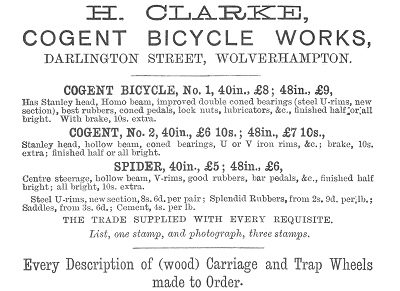
An advert from 1877.
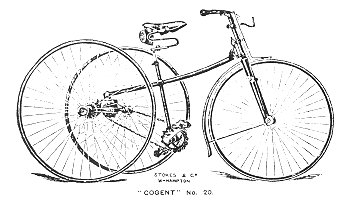
| The Cogent
No. 20 tricycle from 1887. Courtesy
of the late Jim Boulton. |
|
The company also produced a number of
tricycles.
The 'Cogent' No.20 of 1887, sold for
£15.10s.0d. It had ball bearings, a large front
wheel to reduce vibration, and a hollow steel
frame, part plated with an enamel finish. |
| The 'Cogent' No.5 high wheeler had seven
eighths of an inch, and three quarters of an
inch non-slipping tyres. The wheels had Crescent
rims, and 60 and 20, No.11 direct spokes.
The
back wheel was 16 inches in diameter, and the
large wheel had four and a quarter inch G.M.
Hubs, and a ten and a quarter inch axle.
The
bicycle had rat-trap coned pedals, and the
cranks had a throw of five and a quarter
inches. The machine cost £4.10s.0d. |
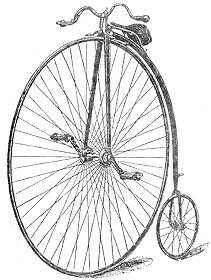
| The Cogent
No. 5 ordinary from 1887. Courtesy
of the late Jim Boulton. |
|
| The 'Gent's Popular' had a weldless
steel tube frame, 28inch wheels, rubber or
rat trap pedals and was finished in black
enamel. The machine was priced at £5.17s.6d. |
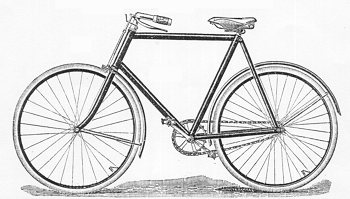
The Cogent Gent's Popular. Courtesy of
the late Jim Boulton. |
|
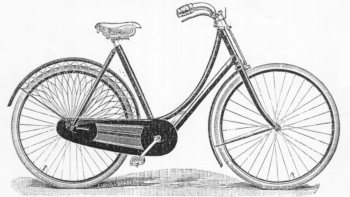
The Cogent Ladies' Popular. Courtesy of
the late Jim Boulton. |
The Ladies' Popular' had a weldless
steel tube frame, 26inch wheels and was
finished in black enamel. The machine was
priced at £6.5s.0d. |
| The following
is a short description of the Cogent No.
10 from "Bicycles & Tricycles of the
Year 1889" by Harry Hewitt Griffin:
"The Cogent No. 10 Dwarf Safety Roadster
(H. Clarke's Executors, Darlington
Street, Wolverhampton). The framing is
composed of strong double tubing, with
extra long centres; the chain adjustment
is effected by drawing forward by a set
screw on the slotted fork end. The curve
of the front forks brings the handles
well back. The machine has no striking
peculiarity, but is well and reliably
made, and is to be depended on. It is
finished with all the usual details,
including direct plunger brake, and with
balls all parts, etc. The price is
£16.10s." |
|
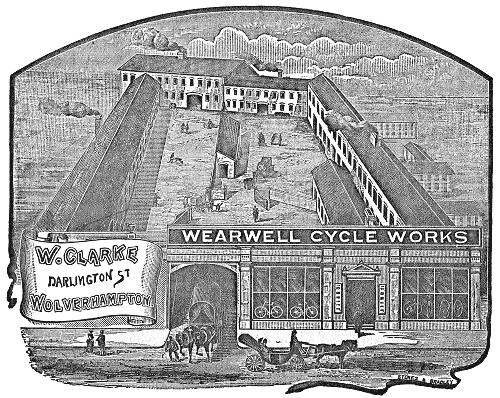
Wearwell's
works at 46 Darlington Street. |
| In the 1881 census Henry Clarke is
listed as living at Darlington Street, Court
2 with his wife Harriet, sons Henry,
William, and John; and daughters Elizabeth,
Jane, Fanny, Harriet, and Emma. His
occupation is given as a bicycle maker
employing 3 men and one boy. Presumably his
other sons, Tom and George, had left home by
this time. Henry Clarke senior died in
1889 at the age of 56, and one of his sons took over the
running of the business. This appears to have
been unacceptable to the other
brothers, and so Joseph Parker took over for the
executors. This resulted in Tom Clarke
leaving for Manchester, where he set up the
Express Cycle Company, while William, Jack,
Henry and George founded Wearwell.
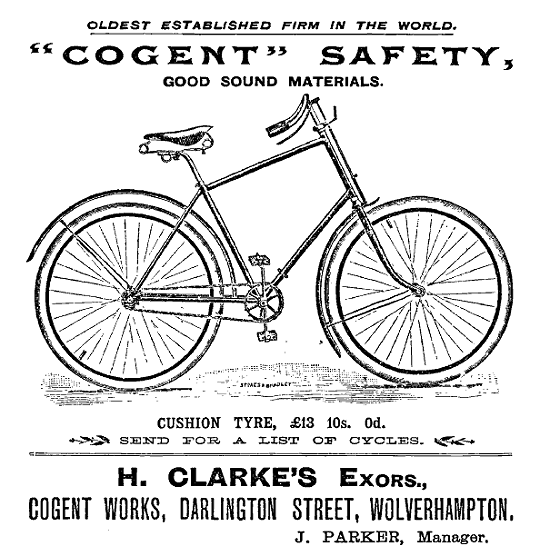
An advert from 1892.
William became Managing Director, and the works
were situated at 46 Darlington Street, a stone's
throw from Cogent, which eventually went into
liquidation. William Married Agnes Ann Pickard
and they had three children: Elsie Elizabeth
Clarke; Henry Steve Clarke; and Albert Clarke.
By 1911 they were living at 6B Oaks Crescent,
Wolverhampton: with William's father-in-law John
Pickard, and a servant. It seems that Cogent ran for at
least ten
years after the formation of Wearwell,
trading as Henry Clarke's
Exors. This can be seen from the date on the
poster below. |
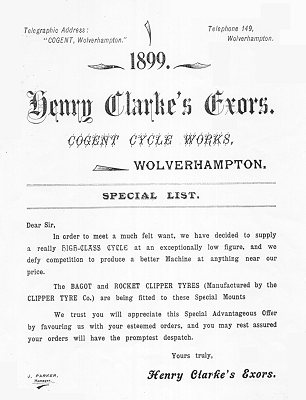
|
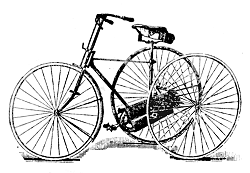
The 1893 Wearwell tricycle. Courtesy of
the late
Jim Boulton. |
Wearwell listed 9 Models in 1893, including
the standard cross frame safety bicycle, which
sold for £10 with solid tyres, or £10.10s.0d
with cushion tyres. There was also a tricycle
that cost £23 with solid tyres, or £29.10s.0d
with Dunlop pneumatics. The most expensive
machine, the model 'A' had a double tubed frame
and was claimed to be the strongest on the
market. The bicycle included ball bearing hubs,
a Reynolds Roller Chain and sold for £18 with
solid tyres, or £23.10s with pneumatic tyres. |
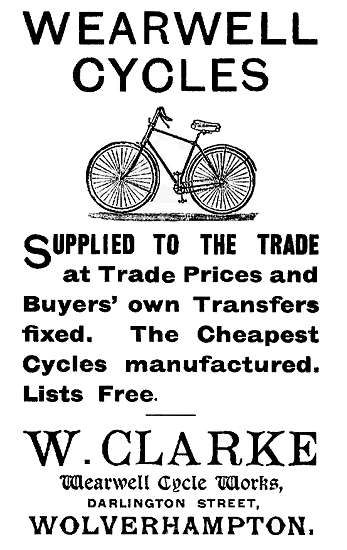
An advert from 1893.
| |
|
View the 1893
Wearwell catalogue |
 |

|
The
following description of the company is from the
"Illustrated Towns of England Business Review of
Wolverhampton" from 1897:
Henry
Clarke's Exors., "Cogent" Cycle Works. A
firm that has gained distinction in the cycle
trade in Wolverhampton is that of Henry Clarke's
Exors., widely known as the Cogent Cycle Works.
The enterprise was founded in 1868, and has had
a career of prosperity, and the evolution of the
cycle from the old bone-shaker to the splendid
machines now in the market, has been due to such
enterprise and inventive skill as has
characterized this firm.
We may
state that the year 1896 proved one of
unprecedented success for this firm, the demand
for their machines being considerably in excess
over former years, in fact, the resources of the
establishment were frequently taxed to meet the
increased trade. In consideration of this
expansion, additions in plant, machinery, and
apparatus have been made and also extensions in
the factories to enable the firm to execute the
anticipated greater demand. The works are
prominently situated and splendidly equipped
with the best improved machinery and appliances.
The
productions are notable for elegance of design,
quality of material, superior workmanship and
finish; while prices are consistently low, in
fact, this firm prides it upon its ability to
supply a machine of unsurpassed excellence at
the lowest possible price. They are built with
the celebrated seamless steel tubes, the
bearings are made from the most reliable steel,
and the gearing and fittings throughout are of
the finest quality. Either racers or roadsters,
for ladies, gentlemen, or youths are
manufactured upon the most scientifical
principles and improved construction. For
specifications and prices an illustrated
catalogue may be obtained from the firm.
The
Cogent cycles have won golden opinions from the
most competent judges and experts, testimonials
being received from all quarters as to their
special merits. An extensive export trade is
done, whilst in the home markets the Cogent
cycles are duly appreciated. An adequate staff
of experienced artisans finds constant
employment, and no efforts are spared by Mr. J.
Parker, the manager, to enhance the reputation
of the firm. |
William Clarke,
Managing Director of Wearwell Cycles.
Courtesy of the late Jim Boulton. |
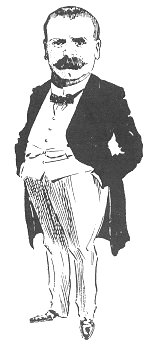 |
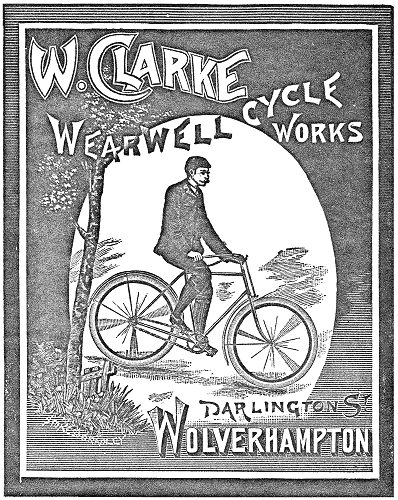
From the 1893 catalogue.
| Sales continued to grow and the
company soon became one of the most important
cycle manufacturers in the town. In 1899
William Clarke had the idea of producing powered
vehicles. He formed the Wearwell Motor Carriage
Company, and opened new premises in Pountney
Street on the site that is now occupied by J. W.
Braithwaite & Son Ltd, bookbinders.
They produced a 4 wheeled, powered vehicle
which had two Butler, two and a quarter horse
power engines, mounted side by side. It was not
generally liked. |

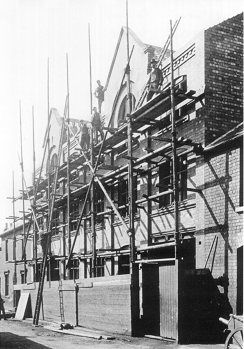 |
This photograph, which
came from Albert Clarke's collection, was given
to us by Geoff Stevens. It shows a small part of
the Wearwell works in Pountney Street during
construction. The
street was originally made up of mainly housing,
which was slowly replaced by factories as the
area became industrialised.
The Wearwell works
eventually covered much of the site that was
later occupied by The Star Engineering Company,
and eventually Braithwaites. It is now a banqueting
suite. The photograph shows
the original building nearing completion. The
houses on each side would eventually disappear
as the works were extended. |
| The location
of Wearwell's factory on the corner of
Pountney Street and Thomas Street.
The site had
previously been occupied by Lion Iron
Works and was advertised for sale by
Nock and Joseland in 1881. |
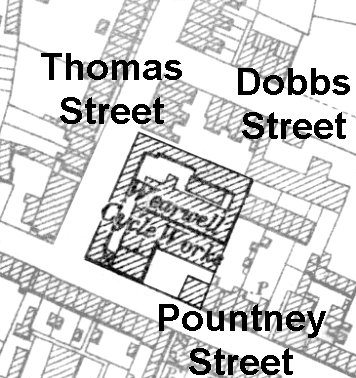 |
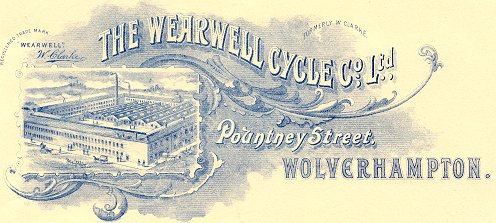
| The
engraving on the company's
letterhead gives a good
impression of the large area
covered by the factory. |
|
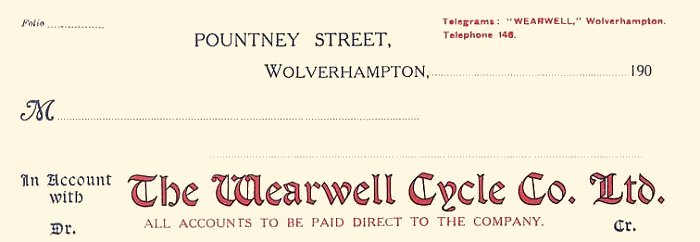
A letterhead from 1907.
| William saw the early Stevens brothers'
motorised bicycle and realised that this was the
way forward. The company already had links with
the Stevens Motor Manufacturing Company, who
supplied spokes and screws for the bicycles.
An agreement was entered with Stevens and a
contract drawn-up. Stevens agreed to supply a
minimum number of engines each week, which were
fitted to heavy duty bicycles.
The new motorcycles were called
Wearwell-Stevens machines, and sales were very
good.
See the motorcycle section for more details. |
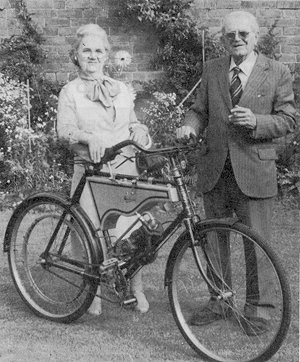
Mr. and Mrs. Albert Clarke with a 1901 Wearwell-Stevens
motorcyle.
Photo courtesy of the late Geoff Stevens. |
|
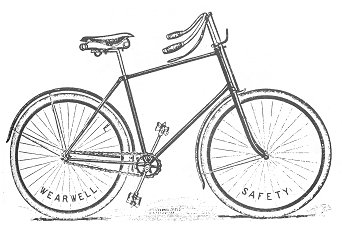 |
The model B from 1893.
The basic bicycle with solid tyres weighed 38lbs
and sold for £16. Dunlop pneumatic tyres were £5
extra and a Carter's gear case could be fitted
for another £3.
Courtesy of the late Jim Boulton.
|
| A ladies cycle from
the 1893 Wearwell catalogue.
Courtesy of the late Jim Boulton. |
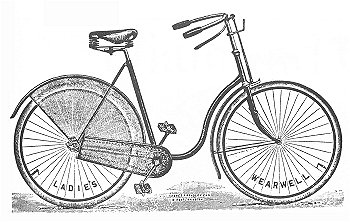 |
| An advert from 1904. |
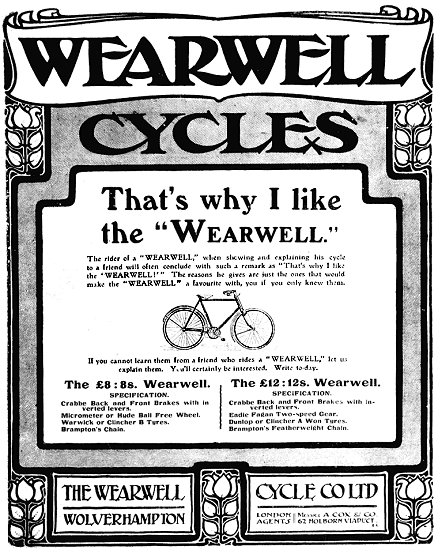 |
|
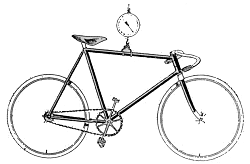
The Wearwell Road Racer. |
By 1905 the company was displaying about 15
models. There was a 7 guinea gentleman's
roadster machine, with Crabbe back and front
brakes, Micrometer, Hyde, or Crabbe free-wheel,
Brampton's chain and Clincher B, or Warwick
tyres. The machine was finished in black enamel
and gold lining. The ladies version cost
£7.12s.6d. There was also a path racing machine
weighing 19 pounds and a road racer which
weighed 21 and a half pounds. |
| The model 'B' weighed
38 pounds, and sold for £16 with solid tyres.
Dunlop pneumatics were an extra £5 and a
Carter's Gear Case cost another £3. |
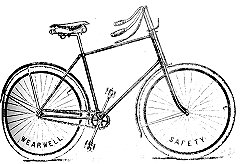 |
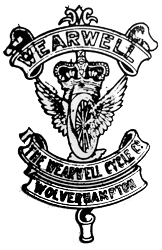 |
By 1908 about 500 machines were produced
each week, many of which were exported. One of
the main importers was Holland, from where
orders of up to 10,000 cycles were not uncommon,
with machines being sold for as little as 27
shillings each. At the same time the company
produced about 20 Wolf motorcycles per week.
Another very different product were 4 wheeled
and 2 wheeled roller skates. At the time roller
skating was extremely popular and most towns had
at least one skating rink. Wearwell designed a
skate with rubber shock absorbers and about 500
pairs a week were sold. 2 wheeled versions were
also widely used and Wearwell produced a version
of their own.
|
| Disaster struck in 1909 when it was
discovered that the Company Secretary, Mr. King,
had been using the company's money to gamble at
pool in a local public house. A large sum of
money had disappeared, which led to the company
going into liquidation in 1911. Mr. King tried
to commit suicide, but William Clarke did not
bring any criminal charges against him, because
he discovered that one of his brothers was also
involved. |
| The
company manufactured and distributed Pickard's Patent Lining
Apparatus, as can be seen from this advert from
1917.
 |
Read about
Pickard's
lining apparatus |
|
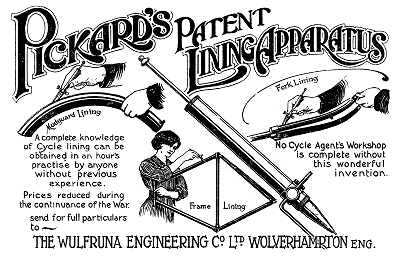 |
|
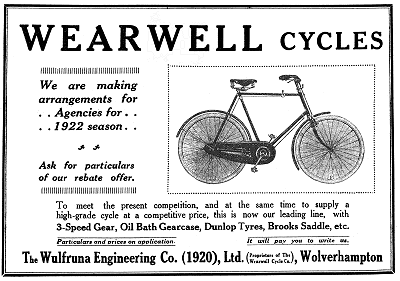
An advert from 1921. Courtesy of the late Jim Boulton. |
After the liquidation, William Clarke
purchased the ailing Wulfruna Cycle Company from
John Barratt. He revitalised the business and
reintroduced the Wearwell and Wolf names at
Eagle works in Great Brickkiln Street. William
died in 1922 and the business was sold to Theo
Waine in 1928. |
| Some members of the Clarke family continued
in the motorcycle business. Jack joined the
Stevens Company in 1911 and became manager, and
Albert, who was Henry's grandson joined H.R.D in
1925 as works manager, when one of their
machines won the Isle of Man T.T. |
| Read about the
Wulfruna Cycle Company |
 |
|
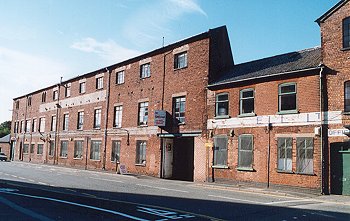
The Old Wulfruna bicycle works in Great
Brickkiln Street. |
|
Joseph Waine & Co. Ltd, were general lock, latch & bolt
makers, and brass and iron founders at Imperial Works, Wood Street,
Willenhall. Joseph had three sons, John Vincent Waine, G. A. Waine and
Horace T. Waine.
John Vincent Waine, and his brother G. A. Waine, started the
Vulcan Manufacturing Company at Blackheath, Birmingham, in about 1910.
The company manufactured Heel Tips, Toe Plates and had the most up to date
machinery in the world. The factory turned out 288,000 pairs of heels per
week, under their Vulcan brand name. The company specialised in a
number of products including No. 0 and 1 York heels, 21B heels, mule & horse
shoes for the Indian, Turkish, African and South American markets, and
japanned and galvanised door bolts. A large number of other products were
produced including the following:
Brass, chromium-plated and special finishes, stainless
steel, garage bolts, cabinet bolts, shelf brackets, aluminium door and gate
latches, casement stays and fasteners, hasps and staples, hinges, brass and
steel gate and tee, gutter brackets, swivel ties, tinned angle brackets,
rim, dead and mortice locks, latches, padlocks, stamped brassware and
household soldering sets.
|
|
The works covered over an acre. Extensive trade
was done with the War Office, the Army and in various parts of
Europe. Horace T. Waine was also involved in the business, and
due to his international travels the products were also sold in
Japan, Burma and Egypt. The company also had an establishment in
the Potteries.
In 1913 the Directors decided to move the three
factories to one site to improve the company's efficiency. In
June a large disused works was purchased in Colliery Road,
Wolverhampton and the three factories were combined under one
roof, and called the New Griffin Works. |
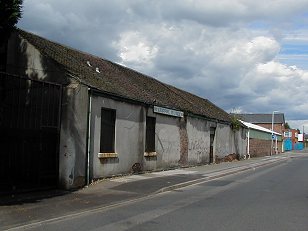
The New Griffin Works today. They are
occupied by hydraulic equipment manufacturer
Hydrofix. All that is left was originally part
of the Vulcan Manufacturing Company. The
Wearwell works have gone. |
|
1914 Whitakers Red
Book, Who's Who in Business:
Joseph Waine & Co.,
Ltd., Merchants and Manufacturers, with
which are amalgamated Luke Lawrence &
Co., Mills & Green, Green Brothers,
Isaac Waine & Co., David Furguson & Co.,
John Arnold & Co., The Brook Tile Co.,
Lincoln Pottery, Burslem; New Griffin
Works, Horsoley Fields, Wolverhampton.
Hours of Business: 9.30 a.m. to 5 p.m.
Established in 1880 by Joseph Waine.
Continued by G. A. Waine, J. Vincent
Waine, and H. T. Waine.
Incorporated as a
Limited Company in 1909. Directors: G.
A. Waine (Managing Director), J. V.
Waine, H. T. Waine. Of the firms
amalgamated, Messrs. John Arnold & Co.
has been established 100 years, and is
under stood to be the oldest firm in the
Brass Lock trade.
Staff: Total of
amalgamated firms, 100 hands, and
Lincoln Pottery employ eighty hands.
Depots and Branches: At Bombay,
Calcutta, Madras, Colombo, Karachi, Hong
Kong, Shanghai, Batavia, Singapore, &c.
Specialities: Locks of all descriptions,
Door Bolts, Safes, Hinges, Rabbit Traps,
Combs, Floor Tiles, Brass Foundry, Tools
and General Hardware, &c. Patents:
Numerous. Connection: United Kingdom,
Foreign, Colonial, Egypt, Holland,
France, South Africa, Canada, Ceylon,
India, Java, China, Japan, Burma,
Australia, New Zealand, &c. Telephone:
No. 521 Wolverhampton. Bankers: Lloyds
Bank Limited. |
|
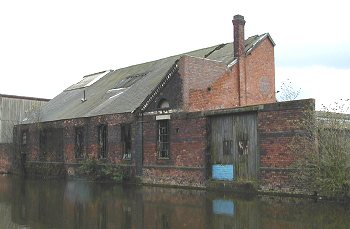
The works back on to the canal where
barges could be loaded and unloaded. |
In 1928, Theo Waine and his brother Mr. G.
A.Waine, took over the Wearwell Cycle Co. Ltd.
from the liquidators of the Wulfruna Engineering
Co. Ltd.
Their sons, H. V. Waine and T. A. Waine were
issued with one ordinary share each, and were
appointed directors at the first shareholders
meeting, which took place at the New Griffin
Works.
The new company was registered as the
Wearwell Cycle Co. (1928) Ltd. |
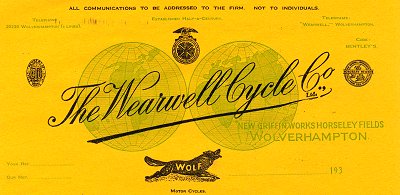
| Initial finance was provided by the issue of
£4,000 worth of £100, 7% debentures which were
the responsibility of H. V. Waine, who had also
been appointed company secretary. At a second
meeting shortly afterwards it was resolved to
purchase from the Vulcan Manufacturing Co.
(Wolverhampton) Ltd, the plant, tools and
stock-in-trade of the cycle manufacturing side
of their business, for £10,209.16s.5d. |
| A full range of machines were on offer in
1929 including tradesmen's cycles, juveniles,
scooters, and the 'Duplex' with a distinctive
cross frame consisting of a thin top tube
running from the seat lug to the fork crown,
with twin tubes running from the steering head
to the rear hub.
The very strong frame weighed only about one
pound more than a conventional diamond frame. |
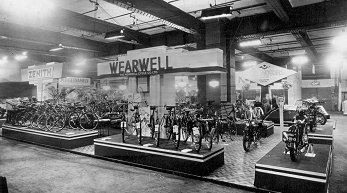
The Wearwell stand at the
1934 motor cycle show. |
| The 'Le Grand' road racer had a double
cog gear hub, 2 calliper brakes and a very
attractive selling price of £5. The top
model the 'Golden Roadster' had a 3 speed
hub, oil bath gear case and sold for
£6.17s.6d. The following year the machines
were on display at the 1930 Olympia Show and
again at the 1931 show with the addition of
the new 'Schneider' sports machine. It had
Endrick rims, 'No Weight' mud guards,
Pelissier brakes and a swan neck handlebar
stem. The new machine sold for £7.10s.0d. A
cheaper version called the 'Wanderer' was
also on offer at £6. |
|
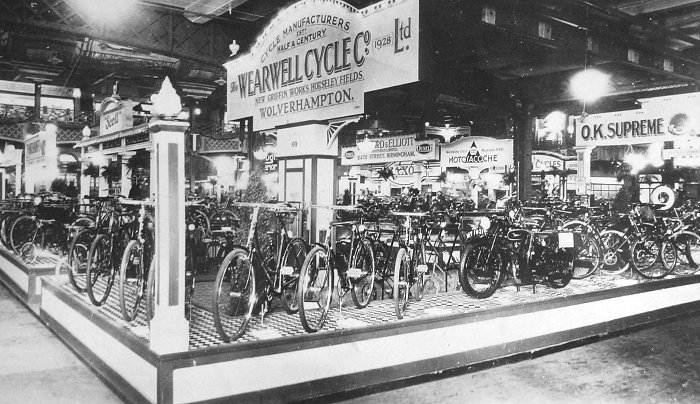
The company's stand at
the 1931 Olympia Show. |

|
The top of a Vulcan Manufacturing Co.
order showing
the company's letterhead. Courtesy of Peter Waine. |
|
The Vulcan Manufacturing Co. (Wolverhampton)
Ltd applied for 6,000 ordinary shares of £l each
to be issued for cash and in 1931 the factory
was expanded and the production of 'Wolf' motor
cycles began. The company prospered and sales
continued to increase, though the works were
damaged by fire. In March 1932 fire fighters
battled for eight hours to control the fire
which caused £10,000 worth of damage. |
| Mr.
H. V.Waine, a keen motorcyclist, was
responsible for the design and production of
both motor cycles and cycles, while Mr. T.
A. Waine was responsible for sales. In July
1932, Mr. G. A.Waine, and Mr. J. V. Waine of
the Vulcan Manufacturing Co. were each
issued with one share each, and appointed
advisors to the company. Waine Eastern
Agencies of Singapore, were appointed sole
selling agents for India, Ceylon, Burma, Straits
Settlements, Siam and China. Other agents
elsewhere were subsequently appointed. |
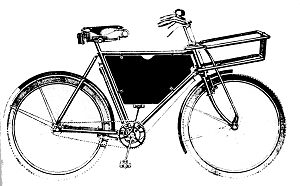
The 1949
'Tradesmen's Carrier' costing
£14.6s.2d. |
|
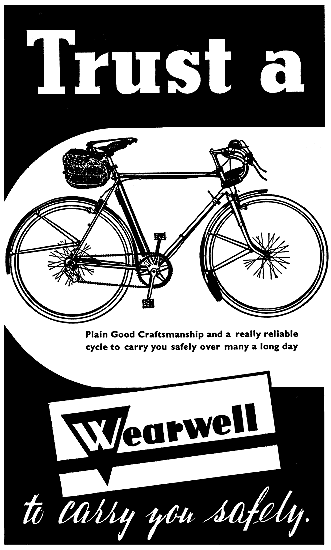
An advert from 1950. |
A considerable number of cycles were
exported to India, and post war Wearwell (India) Ltd, a wholly Indian owned
company, manufactured cycles with technical
support from the Wolverhampton company,
which had reverted to the title of the
Wearwell Cycle Co. Ltd. in 1933.
Motor cycle production ceased during the
war and was not restarted post-war. H. V.
Waine, who was an air raid warden during the
war, remarked one night during the blitz
that there was quite a blaze on the horizon,
only to discover it was his own factory!
The workers set-to the following day and
soon had some production restored. The
factory buildings were soon rebuilt, though
fire damaged machinery was not all cleared
away until after the end of the war.
After the war the cycle side of the business
continued to be successful with 75% of sales
going to around 38 different countries and the
company cycle team won the Tour of Britain cycle
race in 1953.
By this time the company was
employing several hundred workers. The company
also developed a toy department which made
childrens' tricycles, swings and other items.
|
| The company's bicycles were sold in many
countries including the U.S.A. The Waine
family had discussions about different
product names for different countries and
decided to use the "Vulcan" name for their
products destined for North America. The
photograph opposite shows the badge on a
Vulcan bicycle from the mid 1950s. |
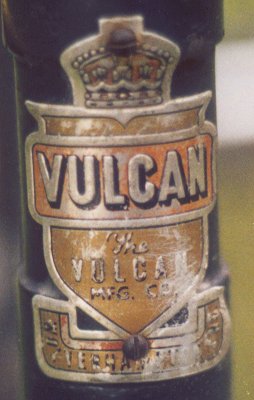
Courtesy of Thomas
Collette. |
|
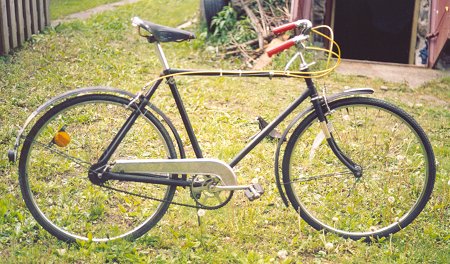 |
Thomas Collette's
excellent Vulcan bicycle from around 1954.
Courtesy of Thomas
Collette. |
| In 1969 the Vulcan Manufacturing company
went into voluntary liquidation, and the
goodwill was sold to Tippers, who were in the
same line of business.
The Wearwell Cycle Co. was also sold, though
production continued on a smaller scale at
Alverley, under Martin Wells, with Mr. H. V.
Waine acting as Chairman. |
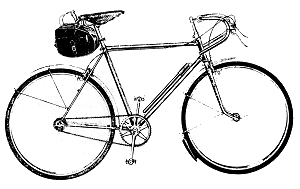
The 1949
'Anglo Continental' that sold for
£16.14s.11d. |
|
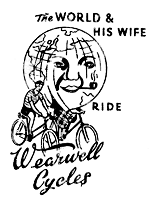 |
After retirement he continued to work for
the company on a part time basis and initially
about 300 bicycles were built each week. The
business was soon sold to the Elswick-Hopper
Cycle Company and production moved to Brigg in
Humberside. Unfortunately sales started to
decline due to the recession and the company
closed. |
|
A
'Wulfruna' bicycle that was made at the New
Griffin Works in about 1957.
photo
courtesy of Peter Hällström. |
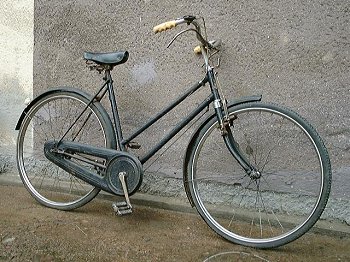 |
| I would like to thank the late Peter Waine, and
Charles V. Waine for their encouragement and
valuable assistance. |
|


